Professional Services
Whether your challenge can be solved by our existing products or requires the development of new analytics solutions and market design approaches, our team is ready to help.
Tertiary Voltage Control Optimization: a successful demonstrator for decision support in the Control Room

.png)
About Transmission System Operators and Voltage Control
Transmission System Operators (TSOs) are responsible for developing, maintaining and operating the high-voltage transmission grid, which carry electricity from the power generation sources to the low-voltage distribution networks. Among others, they are responsible to ensure the voltage stability, which is essential to guarantee system security and reliability.
On the network, actual voltage levels fluctuate over time depending on generation, consumption, and cross-border flow profiles. This is why TSOs have to regulate it with voltage control devices such as tap-changing transformers, which adjust the voltage levels at specific points of the network, or with reactive power control devices, which act as reactors or capacitors to adjust the reactive power balance. In this way, voltages can stay as close as possible to their reference values.
Voltage control is however getting more and more complex over time, due to several causes. Among them, we can mention:
- The increasing dynamic needs of reactive power: more and more Renewable Energy Sources (RES) are connected to the grid, which makes the overall generation less predictable and more volatile. More dynamic reactive power is then necessary to mitigate the fluctuations and ensure stable voltage levels.
- Fewer traditional generators are and will be delivering this reactive power need due to nuclear or coal phase-out.
- The increasingly distributed actions mean and decentralized RES, making decision-making more difficult: the number of devices that can be used is greater and this adds complexity to finding optimal actions, with no obvious activation patterns.
N-SIDE co-created a demonstrator with Elia Group and EGI
As one of the top 5 leading TSOs in Europe, Elia Group provides society with a robust power grid, supplying 30 million end users with electricity and with a reliability of 99.99%. Encompassing two strategically located European regions, Elia in Belgium and 50Hertz in Germany, Elia Group aspires to be a catalyst for a successful energy transition. In this context, Elia Group was looking for an innovative decision-support solution for optimizing voltage control.
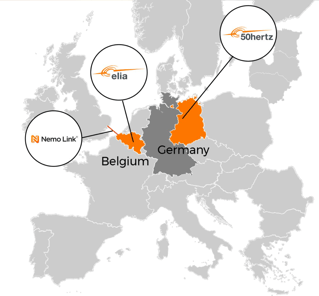
This is where N-SIDE comes in, bringing its highly skilled data scientists, software engineers and energy experts to co-create a demonstrator with a consortium from Elia Group and EGI.
With its advanced analytics expertise and deep knowledge in AI applied to the Energy sector, N-SIDE appears to be the right partner for this type of challenge, as emphasized by Filip Carton, Head of National Control Center at Elia Group:
“Supporting our control room with algorithms to optimize reactive power is one of our biggest priorities, but it’s also very complex, luckily we have N-SIDE as a partner to co-create these solutions.”
Filip Carton, Head of National Control Center, Elia
A challenging problem to solve
Let’s deep dive into the specific problem to solve, and why it is highly complex. Here are the main reasons.
Firstly, because of the size of the grid and its large action space.
For this problem, we considered a grid with 1000+ substations, and an action space made of 100+ tap-changing transformers, 100+ flexible generators, 40+ shunt reactors/capacitors, and 600+ transmission lines and cables to possibly disconnect.
Secondly, because of the N-1 criterion.
This means that actions suggested by the algorithm must leave or put the transmission grid in a state that will remain safe in the event of almost any single possible incident occurring on the network. To ensure this, system operators usually perform contingency analyses, which involve simulating single incidents one at a time, performing a power flow analysis for each case, and verifying that the resulting values remain within acceptable ranges for all assets of the grid. In the context of this problem, the N-1 criterion must be verified for each action proposed by the algorithm.
And thirdly, because of the need for anticipation.
The solution must not only be able to optimize one hour after another individually. It must also be able to optimize batches of several hours as a whole: suggest preventive actions anticipating voltage difficulties, and optimize in such a way that subsequent hours follow each other smoothly and that the actions have a long validity.
Without limiting the number of actions that can be taken to solve the voltage issues on the grid, this leads to a huge number of more than 10^200 possibilities. Taking into account the many constraints and the fact that the solution should be computed in near real-time, the challenge was daunting, impossible to solve by brute-force, hence the need for an innovative algorithm to meet the challenge.
Key ingredients of our solution and covered aspects
How to address this challenging problem? The developed solution relies on three main ingredients.

First, the use of the locality: voltage issues can often be solved locally, and in most cases, it is possible to significantly reduce the complexity of the problem to solve when heuristics are implemented to tailor the size of the search area and thus considering just a subset of the grid.
Secondly, leveraging linearity where possible to avoid running many load-flow analyses. On this aspect, N-SIDE developed an approximation that keeps track of both active and reactive powers, as well as voltage deviations. It is, therefore, a faster approximation than an AC power flow, but much more accurate than the well-known DC approximation. This approximation is then strategically used at specific steps of the optimization process, in order to speed it up considerably.
Finally, the forward-looking ingredient, describes and solves the optimization as a single problem for the entire time period to be optimized. This specific implementation addresses the need for anticipation and allows the demonstrator to identify the best time to perform an action, thus avoiding the back-and-forth on a single asset.
With these ingredients at hand, the team developed a solution minimizing the voltage deviations of the busbars from their target values, while maximizing the MVAr free dynamic flexibility. The solution is taking into account the looking-forward dimension, the N-1 criterion, and also specific costs for using the action means, making it possible to give priority to specific action means over others.
Regarding the constraints, the solution considers asset constraints such as voltage limits, or PQ diagram limits for generators, as well as operational constraints such as a configurable maximum number of actions per time period.
Finally, the possible action means covered in the solution include QMVAr setpoints of static/synchronous generators, station controller (e.g. reactive power droop control, voltage droop control), shunt inductive/capacitive compensation, two and three-winding transformer tap changes, and line/cable connection/disconnection.
Results and perspectives
Less than 9 months after the beginning of the proof-of-concept, the prototype showed successful results: the list of actions generated by the algorithm and reviewed by the Elia Group experts successfully optimized the entire Belgian transmission grid and was able to considerably decrease the initial voltage issues (see Figure A) and further center the voltage values around their targets (see Figure B) on the tested data.
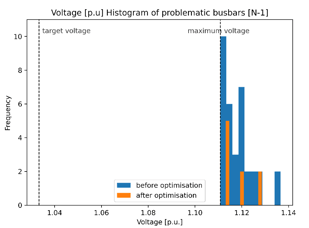
Figure A: After optimization tested on a batch of real data, most of the overvoltages disappear.
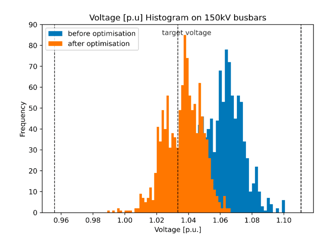
Figure B: After optimization is tested on a batch of real data, the voltages are better distributed around the target.
This is a green light for industrialization. And this is precisely what Elia Group is planning for the future: the industrialization track was kick-started in January 2023, with the goal of having a solution ready to use in production by the end of 2024 / beginning of 2025.
At N-SIDE, this solution is getting further developed with a focus on interoperability & integration to ensure seamless integration in the control room, while reinforcing the algorithm with machine learning to be able to learn from already explored situations.
Once integrated into the control room of the future, the impact of such a solution promises to be substantial: a close to real-time decision support software, bringing an innovative algorithm to handle voltage issues, together with transparency, robustness, safety (N-1), and anticipation. And let us not forget the cost reduction that such a solution can achieve, thanks to the avoidance of costly re-dispatch actions that would have been necessary without it.
Interested in knowing more?
If you want to know more about our voltage control optimization software, you can reach out to Raúl Maza Ruiz, Business Development Manager for N-SIDE Grid Solutions (rma@n-side.com).



About the Author
Noémie holds a Master's degree in Computer Engineering from UCLouvain (Belgium) with a specialization in Artificial Intelligence. She works on industrial and R&D projects involving optimization and machine learning with applications in the energy domain, such as in power system operations.
Noémie Verstraete





Case Study
N-SIDE makes pan-European, single-day-ahead coupling possible with EUPHEMIA
In this case study, we detail the history, inner workings, and results of the PCR EUPHEMIA algorithm, which is used by 26 countries across Europe.
Read more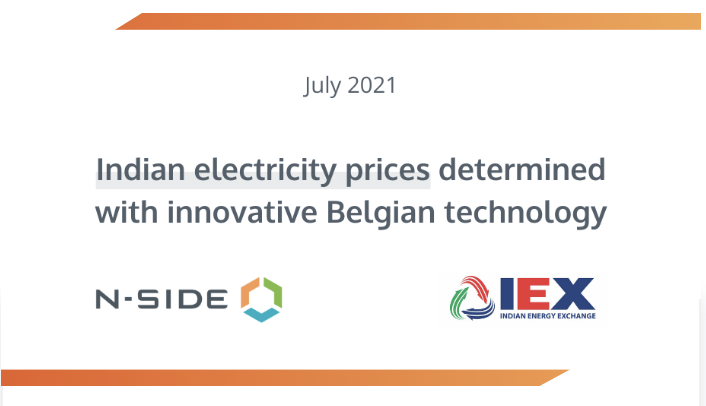
News
Indian electricity prices determined with innovative Belgian technology
India’s premier Power Exchange IEX partners with N-SIDE to implement its Power Matching Algorithm for price discovery in its Day-Ahead Market
Read More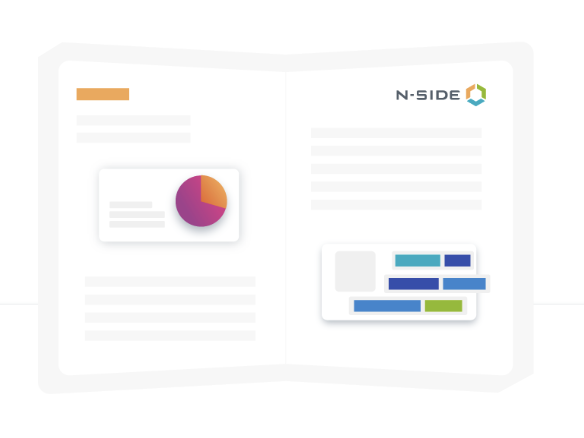
Brochure
Power Matching Algorithm for power exchanges
Optimize your energy and capacity markets by matching supply and demand in closed-gate auctions. N-SIDE’s Power Matching Algorithm for power exchanges is an auction optimization algorithm that can be integrated within new or existing energy market operations.
Download Now









